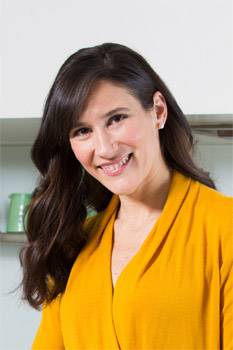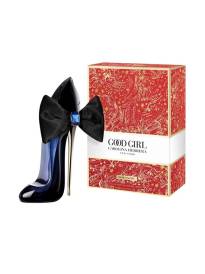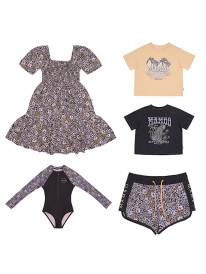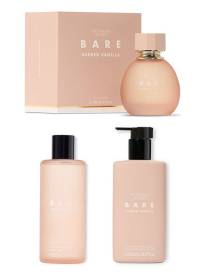Melanie McGrice Low In Iron Interview

Melanie McGrice Low In Iron Interview
You don't need to turn into a beef and spinach eating machine to meet your iron requirements. Dietitian Melanie McGrice divulges 5 iron rich foods that may surprise you.
One in 5 Australians are low in iron. Iron is an important mineral responsible for making proteins that carry oxygen in the blood to give our bodies the energy needed to function. Low iron can result in anaemia which can leave you fatigued, pale, dizzy and out of breath. It is more prevalent in women with menstruating women, pregnant and lactating women, teenage girls and female athletes being most at risk. The Recommended Daily Intake of iron for a male is 8mg/day whereas for females it increases to 18mg/day to balance out what is lost in the menstrual cycle.
When asked to increase your iron intake your mind may think of a bloody red steak or even leap to the conclusion that you need iron supplements, but this is not always the case. There are plenty of iron rich foods that can be incorporated into your daily diet, so if you're concerned that you're not getting enough iron continue reading to discover the 5 most under-rated iron-rich foods.
Sesame seeds
Nuts and seeds are a good source of healthy fats, fibre, vitamins and minerals, but sesame seeds have the highest iron content of them all! 100g sesame seeds have approximately 14.5mg iron! Now remember to be reasonable as it's not likely that you're going to sit down to a 100g sesame seed serve, but sprinkling a little on top of an Asian stir-fry or ordering a sesame seed bread roll as opposed to plain can be a good idea to boost your iron intake.
Oysters
These little delicacies really pack a punch of nutrition. In addition to being a good source of protein, omega-3 and zinc, oysters are a fantastic source of iron. A 100g portion, which is equivalent to 6 medium oysters, will give you approximately 7mg iron. Continue to indulge if you love them or use this tip as a reason to give them a go!
Lentils
Lentils are a type of pulse and come in different colour varieties but yellow, red, green and brown lentils are most common. 1 cup of cooked lentils provides 6mg iron with virtually no fat and no cholesterol. They're also a really good source of protein so don't be scared to go vegetarian more often.
Sourdough bread
Bread has been a staple in Western diets for centuries and is a good source of B vitamins, dietary fibre and iron. To increase your iron intake, I'd recommend a high-fibre sourdough bread. Sourdough bread has a lower phytate content than whole wheat flour (phytates are compounds that bind to other minerals rendering them unavailable for nutrient absorption) meaning that there is more iron for you to absorb per slice. 2 slices (approximately 100g) of sourdough bread provides 3.5mg iron
Kale
Kale is one of those new superfoods that we just can't get enough of. Well, maybe that is because it is so good for you! Being a dark green leafy vegetable it is comparable with its cousin, Popeye's iron-superfood, spinach. There is approximately 1mg iron in 1 cup of kale so continue adding it to your omelette, salads and green smoothies.
If you think you are at risk of being low in iron, or if it has been confirmed through a blood test, talk to your Dietitian about adding more iron-rich foods in your diet. If you have iron deficiency anaemia, your Dietitian can also recommend a suitable iron supplement for you to take to boost your levels and then monitor your iron intake to prevent further deficiencies.
One in 5 Australians are low in iron. Iron is an important mineral responsible for making proteins that carry oxygen in the blood to give our bodies the energy needed to function. Low iron can result in anaemia which can leave you fatigued, pale, dizzy and out of breath. It is more prevalent in women with menstruating women, pregnant and lactating women, teenage girls and female athletes being most at risk. The Recommended Daily Intake of iron for a male is 8mg/day whereas for females it increases to 18mg/day to balance out what is lost in the menstrual cycle.
When asked to increase your iron intake your mind may think of a bloody red steak or even leap to the conclusion that you need iron supplements, but this is not always the case. There are plenty of iron rich foods that can be incorporated into your daily diet, so if you're concerned that you're not getting enough iron continue reading to discover the 5 most under-rated iron-rich foods.
Sesame seeds
Nuts and seeds are a good source of healthy fats, fibre, vitamins and minerals, but sesame seeds have the highest iron content of them all! 100g sesame seeds have approximately 14.5mg iron! Now remember to be reasonable as it's not likely that you're going to sit down to a 100g sesame seed serve, but sprinkling a little on top of an Asian stir-fry or ordering a sesame seed bread roll as opposed to plain can be a good idea to boost your iron intake.
Oysters
These little delicacies really pack a punch of nutrition. In addition to being a good source of protein, omega-3 and zinc, oysters are a fantastic source of iron. A 100g portion, which is equivalent to 6 medium oysters, will give you approximately 7mg iron. Continue to indulge if you love them or use this tip as a reason to give them a go!
Lentils
Lentils are a type of pulse and come in different colour varieties but yellow, red, green and brown lentils are most common. 1 cup of cooked lentils provides 6mg iron with virtually no fat and no cholesterol. They're also a really good source of protein so don't be scared to go vegetarian more often.
Sourdough bread
Bread has been a staple in Western diets for centuries and is a good source of B vitamins, dietary fibre and iron. To increase your iron intake, I'd recommend a high-fibre sourdough bread. Sourdough bread has a lower phytate content than whole wheat flour (phytates are compounds that bind to other minerals rendering them unavailable for nutrient absorption) meaning that there is more iron for you to absorb per slice. 2 slices (approximately 100g) of sourdough bread provides 3.5mg iron
Kale
Kale is one of those new superfoods that we just can't get enough of. Well, maybe that is because it is so good for you! Being a dark green leafy vegetable it is comparable with its cousin, Popeye's iron-superfood, spinach. There is approximately 1mg iron in 1 cup of kale so continue adding it to your omelette, salads and green smoothies.
If you think you are at risk of being low in iron, or if it has been confirmed through a blood test, talk to your Dietitian about adding more iron-rich foods in your diet. If you have iron deficiency anaemia, your Dietitian can also recommend a suitable iron supplement for you to take to boost your levels and then monitor your iron intake to prevent further deficiencies.
Interview with Melanie McGrice
Melanie McGrice is one of Australia's best known dietitians. She is a highly respected author and health presenter on nutrition and dietary issues - and a lover of great food! Join her free nutrition and wellbeing network at www.melaniemcgrice.com.au
Question: Why do females need to monitor their iron levels?
Melanie McGrice: Iron deficiency is quite common in females as we lose iron each month during our periods. Blood is one of the most concentrated sources of iron.
Question: What symptoms are associated with low iron levels?
Melanie McGrice: The most common symptom is tiredness, but as that is so common, other key symptoms to look out for are pale gums and deformed fingernails.
Question: Why is it best to visit a nutritionist when you are diagnosed with low iron levels?
Melanie McGrice: Because even though you might be able to correct the deficiency with tablets, you won't treat the cause of the problem unless you take a good, hard look at your diet.
Question: Are there foods as high in iron as red meats?
Melanie McGrice: Although red meat is the richest source of iron (other than offal – but that's not eaten too often these days!!), a serve of red meat only provides 3mg of iron. To meet the recommended 18mg of iron each day, you need to choose lots of foods which contain iron including wholegrains, green leafy vegetables and fish.
Question: What foods should we incorporate into our daily diet to ensure we do not become iron deficient?
Melanie McGrice: One of my favourite tips is to ensure that females choose brown bread, rice and pasta as they have more iron than white, refined versions.
Question: Why is it best to get our iron from foods rather than supplements?
Melanie McGrice: Having too much iron can also cause problems such as constipation and competing with other key micronutrients. When we get our iron from a healthy diet, we are much more likely to get the right amounts.
Question: What's so great about Kale?
Melanie McGrice: Kale is rich in a number of great micronutrients, including iron.
Question: What other superfoods are you currently eating and recommending?
Melanie McGrice: I'm really enjoying adding quinoa to salads at the moment. It's a great source of protein, magnesium and fibre as well as iron.
Question: Why is it important that Australians visit dietitians?
Melanie McGrice: Food is medicine. By eating a healthy diet that has been designed to suit your personal requirements, it really increases your health and vitality.
Question: What's a typical working day like, for you?
Melanie McGrice: Busy! I could never get done everything that I need to each day if I didn't have a healthy diet and lifestyle to fuel my day. My days contain a lot of variety – which is one of the things that I love most about dietetics – but a typical day would usually look like:
6.00 wake, check my phone for new emails, use the quiet time to think about any key issues that I need to deal with that day
6.30 prepare for the day (shower, brekkie etc) then ride my pushbike into work
7.30 update my social media
8.00 I love to use this hour before everyone else arrives in the office to get some key project work done. I think most clearly so I use this time to work on projects. Examples might include writing corporate proposals, writing presentations, writing articles or writing briefs for my staff.
10.00 I usually get at least one media request each day, so I usually organise these mid morning.
11.00 Mornings are often also busy with meetings – whether with my staff or with companies that I am doing consultancy work for.
1.30pm lunch
2 – 7pm I reserve this time for seeing clients. As our target market are more inner city, well educated people they prefer to come after work.
7pm finish up any meal plans and correspondence
7.30pm head home and prepare dinner/catch up with a friend/go for a walk
10pm bed
Article by Melanie McGrice
Interview by Brooke Hunter
Question: Why do females need to monitor their iron levels?
Melanie McGrice: Iron deficiency is quite common in females as we lose iron each month during our periods. Blood is one of the most concentrated sources of iron.
Question: What symptoms are associated with low iron levels?
Melanie McGrice: The most common symptom is tiredness, but as that is so common, other key symptoms to look out for are pale gums and deformed fingernails.
Question: Why is it best to visit a nutritionist when you are diagnosed with low iron levels?
Melanie McGrice: Because even though you might be able to correct the deficiency with tablets, you won't treat the cause of the problem unless you take a good, hard look at your diet.
Question: Are there foods as high in iron as red meats?
Melanie McGrice: Although red meat is the richest source of iron (other than offal – but that's not eaten too often these days!!), a serve of red meat only provides 3mg of iron. To meet the recommended 18mg of iron each day, you need to choose lots of foods which contain iron including wholegrains, green leafy vegetables and fish.
Question: What foods should we incorporate into our daily diet to ensure we do not become iron deficient?
Melanie McGrice: One of my favourite tips is to ensure that females choose brown bread, rice and pasta as they have more iron than white, refined versions.
Question: Why is it best to get our iron from foods rather than supplements?
Melanie McGrice: Having too much iron can also cause problems such as constipation and competing with other key micronutrients. When we get our iron from a healthy diet, we are much more likely to get the right amounts.
Question: What's so great about Kale?
Melanie McGrice: Kale is rich in a number of great micronutrients, including iron.
Question: What other superfoods are you currently eating and recommending?
Melanie McGrice: I'm really enjoying adding quinoa to salads at the moment. It's a great source of protein, magnesium and fibre as well as iron.
Question: Why is it important that Australians visit dietitians?
Melanie McGrice: Food is medicine. By eating a healthy diet that has been designed to suit your personal requirements, it really increases your health and vitality.
Question: What's a typical working day like, for you?
Melanie McGrice: Busy! I could never get done everything that I need to each day if I didn't have a healthy diet and lifestyle to fuel my day. My days contain a lot of variety – which is one of the things that I love most about dietetics – but a typical day would usually look like:
6.00 wake, check my phone for new emails, use the quiet time to think about any key issues that I need to deal with that day
6.30 prepare for the day (shower, brekkie etc) then ride my pushbike into work
7.30 update my social media
8.00 I love to use this hour before everyone else arrives in the office to get some key project work done. I think most clearly so I use this time to work on projects. Examples might include writing corporate proposals, writing presentations, writing articles or writing briefs for my staff.
10.00 I usually get at least one media request each day, so I usually organise these mid morning.
11.00 Mornings are often also busy with meetings – whether with my staff or with companies that I am doing consultancy work for.
1.30pm lunch
2 – 7pm I reserve this time for seeing clients. As our target market are more inner city, well educated people they prefer to come after work.
7pm finish up any meal plans and correspondence
7.30pm head home and prepare dinner/catch up with a friend/go for a walk
10pm bed
Article by Melanie McGrice
Interview by Brooke Hunter
MORE





